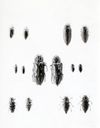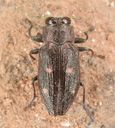Chrysobothrini
Chrysobothrini
Classification
- Phylum: Arthropoda
- Subphylum: Hexapoda
- Class: Insecta
- Order: Coleoptera
- Suborder: Polyphaga
- Superfamily: Buprestoidea
- Family: Buprestidae
- Subfamily: Buprestinae
- Tribe: Chrysobothrini
Pronunciation
How to pronounce Chrysobothrini: //ˌkrɪsoʊboʊˈθraɪnaɪ//
These audio files are automatically generated. While they are not always 100% accurate, they are a good starting point.
Images






Summary
Chrysobothrini is a tribe of metallic wood-boring beetles comprising at least 140 described species and primarily belonging to the genus Chrysobothris. They play a significant ecological role in forest habitats as decomposers, although some can be economically damaging to timber.
Physical Characteristics
Members of Chrysobothrini are recognized for their metallic luster and elongated bodies typical of wood-boring beetles.
Identification Tips
Look for metallic coloration and oblong body shape; they are generally found on or near their host trees.
Habitat
They inhabit forested areas and are commonly associated with wood in various stages of decomposition.
Distribution
Chrysobothrini can be found throughout North America, with over 700 species worldwide.
Diet
They primarily feed on the wood of trees, often causing damage to the wood as larvae burrow. Adults may also feed on foliage.
Life Cycle
The life cycle includes egg, larval, pupal, and adult stages; larvae are wood-borers, creating strong galleries within their host.
Reproduction
Mating occurs on host trees, and females lay eggs in crevices of the wood.
Predators
Natural predators include birds and some predatory insects, which may feed on the larvae or adults.
Ecosystem Role
As decomposers, they assist in breaking down dead or dying trees, contributing to nutrient cycling.
Economic Impact
Some species can be structurally damaging to timber and are considered pest species in forestry.
Collecting Methods
- Hand collection from host trees
- Light traps
Preservation Methods
- Pinning
- Alcohol preservation
Evolution
Chrysobothrini evolves as a part of a lineage with diverse adaptations for wood-boring and feeding.
Similar Taxa
Misconceptions
They are often confused with other wood-boring species but can be differentiated by their distinct metallic coloration.
Tags
- beetles
- Coleoptera
- Buprestidae
- wood-boring
- Chrysobothrini